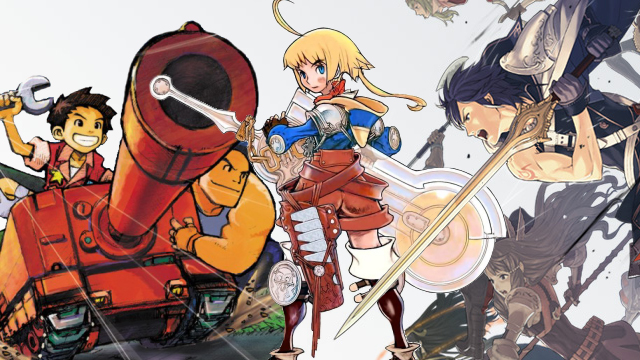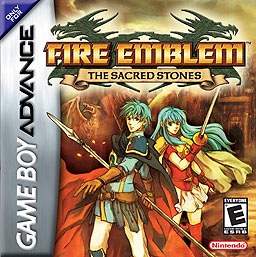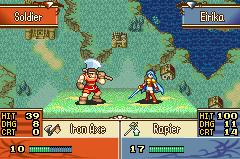

Genre: Tactical Role-Playing Game
Accessibility: 4/5
Fun Factor: 4/5
The only game that lets you choose a difficulty level, Sacred Stones begins much like FFTA with a story-heavy intro and a very user-friendly tutorial. The only difference, however, is that Sacred Stones is about hundred times more exciting! Okay, so the first fight in the opening prologue is heavily scripted, but watching a pack of snails throw snowballs at each other just doesn’t quite compare to knights on horseback holding off an invading army.
To be fair, there’s a lot more to get your head round than FFTA, though not quite as much as Advance Wars 2 (at least not at first, anyway), but everything you do is much more engrained into the game’s overall story than either game put together. The familiar movement and attack grid is back again, but you can visit towns to get battle tips from the local villagers or warn them about invading thugs, you can recruit other “neutral” characters into joining your cause, and certain characters who have a close relationship can also receive special attack boosts if their supporting partner is nearby.

Seeing battles in more detail definitely adds to the drama of each fight.
There’s also a Pokémon-style twist to combat this time round, too, in the form of the weapon triangle. This dictates which weapons have an advantage over others, and it’s by far the most important strategy you’ll have to learn. There are other tactics to take into consideration as well, such as seizing certain buildings like castles and thrones to restore HP or using the terrain to your advantage– but these seem to play a slightly lesser role in Sacred Stones than they do in Advance Wars 2, for example.
Instead, it’s the weapon triangle that takes centre stage in most battles, but as its name implies, there are only three types of weapon to take into account at any one time, and this leaves it feeling a little unvaried when you compare it to everyone’s favourite catch ’em all elements table. But when each weapon has a set number of uses before it breaks, it’s never simply a case of picking the right tool for the job. You’ve also got to manage your weapon inventories, taking into account its stats and making sure everyone’s kitted out with enough stuff to survive the next battle. Handy, then, that some castles also double up as armouries as well, and this is just the sort of thing that helps bind the story and strategy together.
The defining feature of the Fire Emblem series though is, of course, the famous “perma-death”. As you might expect, this really does make every individual fighter that much more precious to you, and even though the first character I lost was Neimi, an archer I’d only just met, it was right after I’d just been told about the support relationships I mentioned earlier. Her support partner was a thief named Colm who she’d just managed to persuade to join my party, but just as I was thinking about all the potential they had as a battle couple, an enemy bandit chucked an axe at her from behind and, well, that was the end of that. It wasn’t hugely heartbreaking given our short time together, but I can tell you now that if I lose Seth or Vanessa somewhere down the line, there will be tears…
So after playing each game for a good five-odd hours, which one is the best for strategy newbies? The winner is…




 ShareThis
ShareThis






